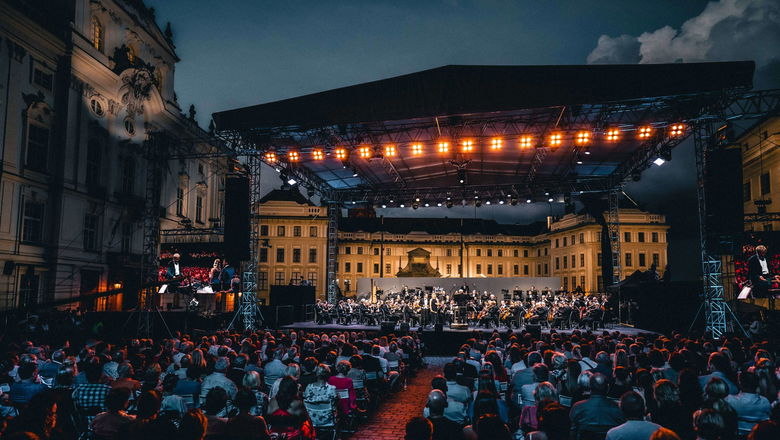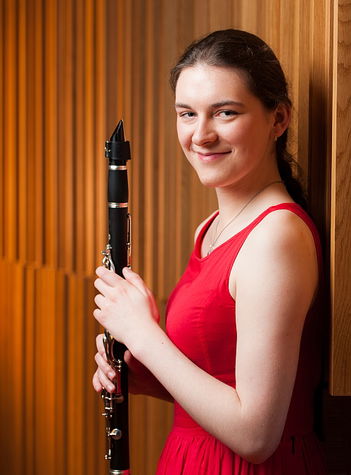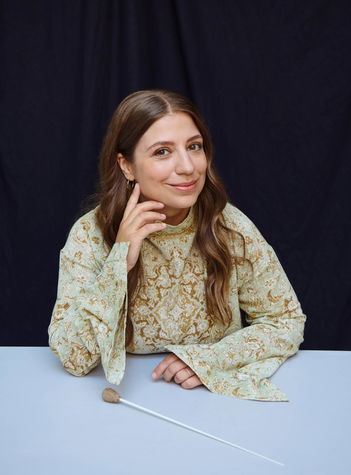To end its concert season, the Czech Philharmonic traditionally offers a selection of compositions that are attractive and popular with audiences or that are chosen to fit with a special theme for the programme. For that reason, at this year’s Open Air Concert features an appearance by the winner of the 2024 Jiří Bělohlávek Prize, the clarinettist Anna Paulová, in the world premiere of Pauliana, a composition for clarinet and orchestra by Jiří Gemrot. The rest of the repertoire on the programme can be characterised briefly by the words “Czech and Moravian folklore, France, and Spain”.
A native of the Moravian town Polička, the composer Bohuslav Martinů (1890–1959) had a warm relationship with the folklore of his own country and also with France. He arrived in Paris in 1923 neither “to find Debussy”, as he himself said, nor in pursuit of Ravel, who was by then still alive but seen as passé, but rather to study under Albert Roussel with the goal of developing his talent. Thanks to many stimuli from the musical avant-garde of the interwar period, he synthesised his own inimitable style, which one also hears in his Overture for Orchestra, H 345. Martinů wrote it in 1953 for the Parent Association at the Mannes College of Music in New York, where he taught from 1948 to 1956. Based on the concerto grosso principle (a tutti orchestra in opposition to a smaller group of instruments), the work is a throwback to the composer’s earlier Neoclassical or Neo-Baroque period.
The title of the Lachian Dances, Op. 2, by Leoš Janáček (1854–1928) makes direct reference to folklore. Interest in the folk arts and dialects of the Moravian Silesia region followed Janáček throughout his musical career. He composed his Lachian Dances (originally Wallachian Dances) at the turn of the 1880s and ’90s, and he later worked some of the motivic material into the ballet Rákos Rákoczy (1891). The only dance he did not later include in the ballet is Starodávný II (Old-Time Dance II) with a motif from the folk song “A já zarmucena” (“And I, full of sorrow”). Contrasting to this slow, broadly sung dance is the following number titled Čeladenský (From Čeladná), the main idea of which is the melody of the song “Ztratil žebrak kabelu” (The Beggar Lost his Bag), which Janáček heard sung in Čeladná. On the basis of that tune, he created a short, spirited piece full of humour and virtuosity. We now know the Lachian Dances in the composer’s later final revision from 1924 as a six-movement cycle, first performed that same year at the National Theatre in Brno.
Maurice Ravel (1875–1937), a composer of Swiss and Basque descent, lived and worked mainly in France. He rightly tends to be associated with Impressionism, but his interest in newer musical trends like Neoclassicism should not be overlooked. Ravel was a master of orchestration and of subtle, fleeting shades of mood, and in Bohuslav Martinů’s words, “his music, while retaining formal polish, makes an almost refined impression”. The Pavane for a Dead Princess (1899), one of Ravel’s best known compositions, is imbued with inspiration from Spain. We are told all we need to know by the choice of the pavane, a slow, courtly dance of Spanish and Italian origin, and by the motif of an unidentified infanta—a young crown princess from the Iberian Peninsula. The Pavane’s fin-de-siècle atmosphere on the one hand and the sorrowful and mysterious (and possibly merely hypothetical) subtext on the other hand certainly contributed to the success of the piece, originally for piano solo; Ravel himself was critical of the work, but he later orchestrated it, publishing that version in 1910.
The Czech composer, director of musical programming, producer, and teacher Jiří Gemrot (*1957) shaped his original musical style in part through the study of the classics (Prokofiev, Martinů, Dvořák, Janáček, Britten). The bulk of Gemrot’s oeuvre consists of chamber music. He pays a great deal of attention to the handling of themes and to musical tectonics as well as to communication between the composer and the listener. This aspect is reflected in Pauliana for clarinet and orchestra with its inspiration from the swing style of jazz. Incidentally, the composer has long taken an interest in combining the past and present as well as in using music to pose philosophical and more general artistic questions. Pauliana opens brilliantly with themes that are recalled intimately by the solo clarinet and then reappear in the brass before the end.
The French Impressionist Lili Boulanger (1893–1918), whose full name was Marie-Juliette Olga Boulanger, exhibited extraordinary musical talent during her short life marred by illness. She became the first female composer to win the Prix de Rome in 1913 at just 19 years of age. About her, the composer and music critic Louis Vuillemin later wrote “She brought to music a keen and prodigiously human sensibility, served in its expression by the full range of natural gifts, from grace, colour, charm, and subtlety to winged lyricism and obvious power, easy and profound.” D’un matin de printemps (Of a Spring Morning) from 1917–1918 is one of her last works, and it exists in three versions: for orchestra, for piano trio, and finally for violin (or flute) and piano. As a counterpart, Boulanger composed D’un soir triste (Of a Sad Evening). The two works share a stylistic and thematic similarity and are wonderfully orchestrated, but they differ, as their titles obviously suggest, in their overall effect, with “Spring Morning” being far brighter and more positive.
Carmen by the French composer Georges Bizet (1838–1875) is now one of the most frequently performed operas worldwide, but its path to the limelight was not easy. To the composer’s disappointment, the 1875 premiere at Paris’s Opéra-comique was not a great success. What was the problem? The subject matter involving the story of a simple gypsy girl employed at a cigarette factory? The choice of a setting in something other than “high society”? Music that might have seemed too complex for the audience? Only after Bizet’s death did Carmen find international success. It benefitted from the popularity of Spanish exoticism, but it also features other common themes of 19th-century Romanticism: smuggling, jealousy leading to tragedy, passionate love, and the “wild” gypsy element. The timelessness of Carmen is documented by two orchestral suites based on musical material from the opera. The arrangement by Bizet’s friend Ernest Guiraud closely follows the original orchestration. The two suites, each with six movements, first appeared in 1885 and 1886. Suite No. 2 contains especially famous numbers like the Habanera (Carmen’s aria from Act II) and the Toreador Song (introduction and Escamillo’s aria from Act II) as well as the Dance Bohéme (Gypsy Dance) that opens Act II and the Nocturne taken from Micaëla’s aria in Act III. The numbers in the suite do not follow the order of the opera’s action.
Maurice Ravel composed his choreographic poem Bolero, M. 81, in 1928 at the height of his fame. Interestingly, he wrote this exciting music on commission rather by chance. The dancer and choreographer Ida Rubinstein had approached Ravel, asking him to write ballet music in a “Spanish mood”, and he, having had the experience of collaborating with Sergei Diaghilev’s Ballets Russes, agreed to do so. Although he had originally considered orchestrating some pieces by Isaac Albéniz, he ultimately decided to create a composition of his own. Bolero is based on two melodic themes with the characteristic rhythm of the bolero, a Spanish dance. The two themes are repeated constantly (AA BB AA…), but the instrumentation and dynamics change. From the moment the rhythm is set in motion with the constant support of the snare drum, the piece undergoes steady dynamic growth as more and more instruments join in; Bolero is said to be perhaps the longest uninterrupted crescendo in music history. In Bolero, Ravel demonstrates his wonderful mastery of orchestration, playfully employing instrumental colours and combinations, building up the sound gradually while succeeding at keeping listeners in almost hypnotic suspense.




